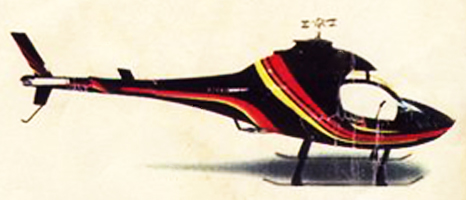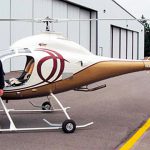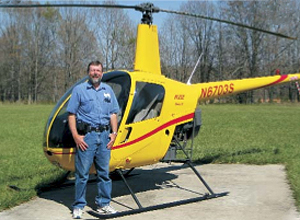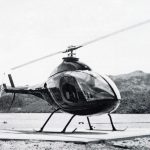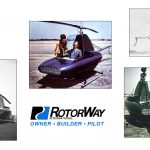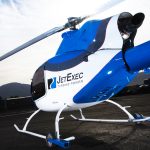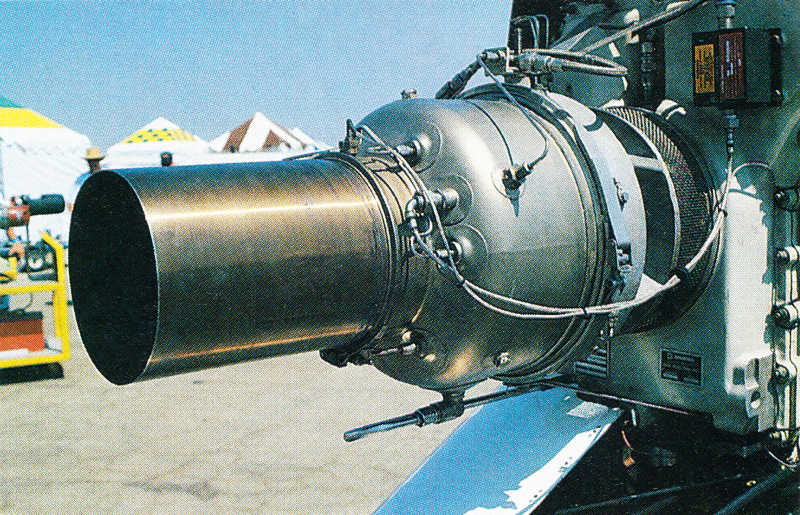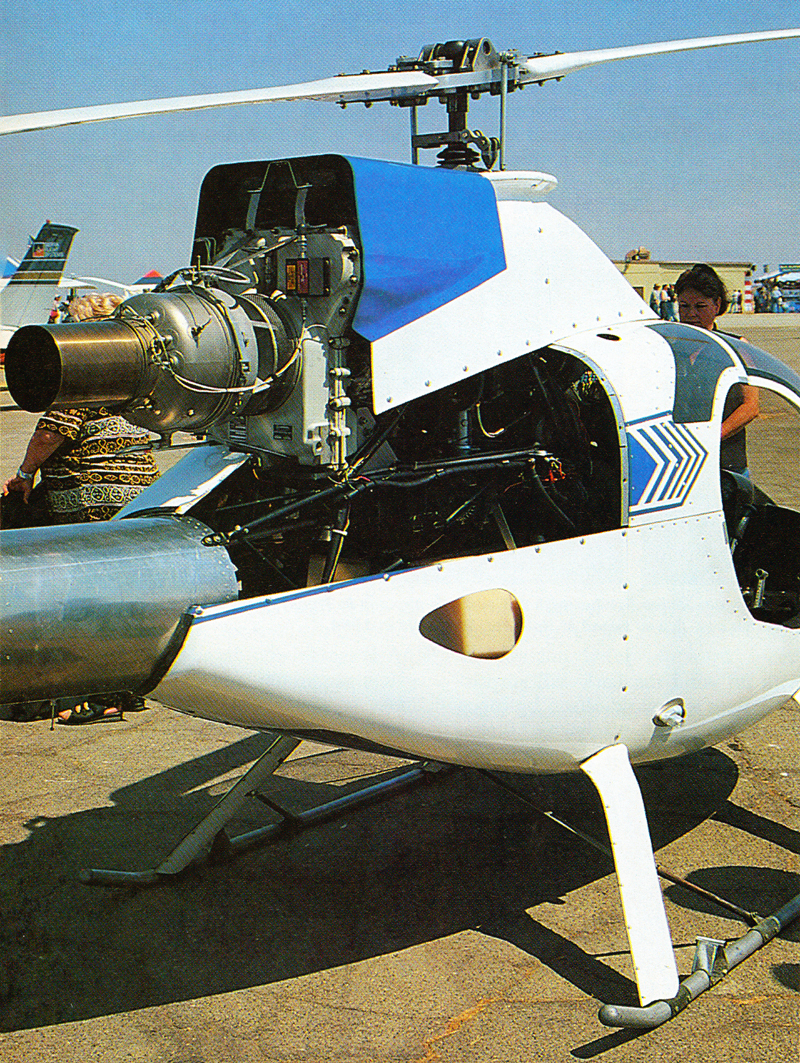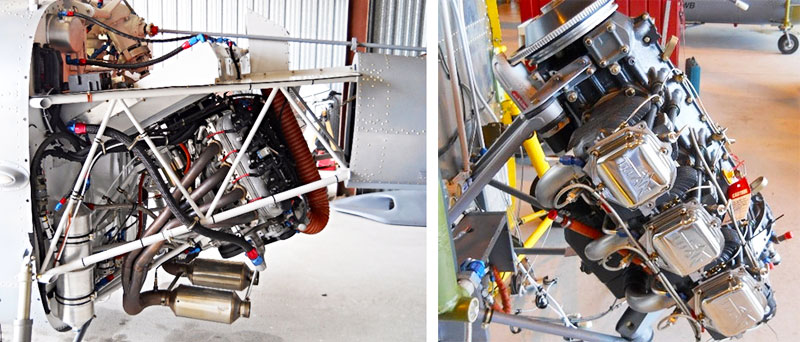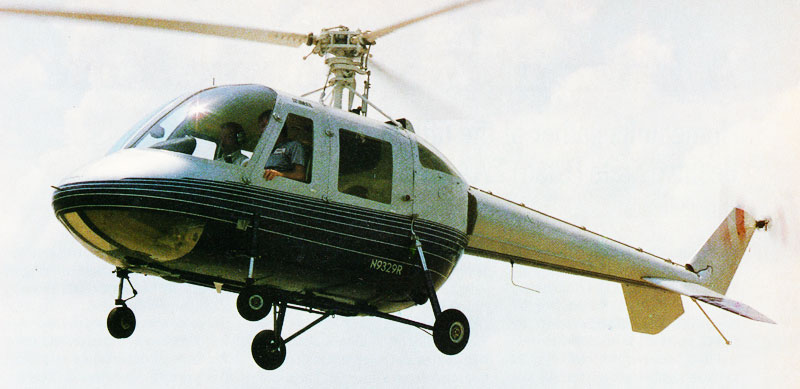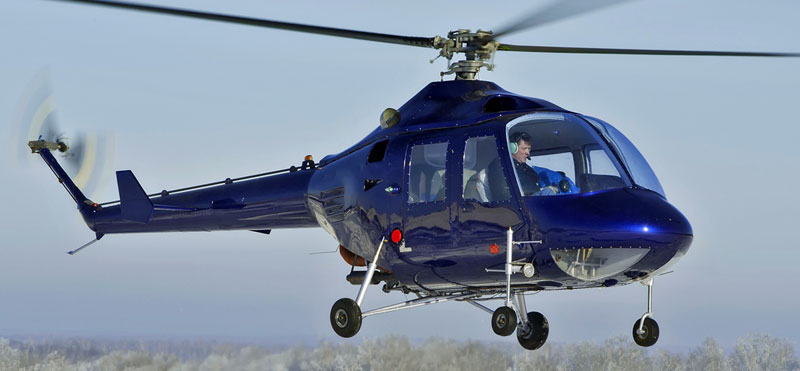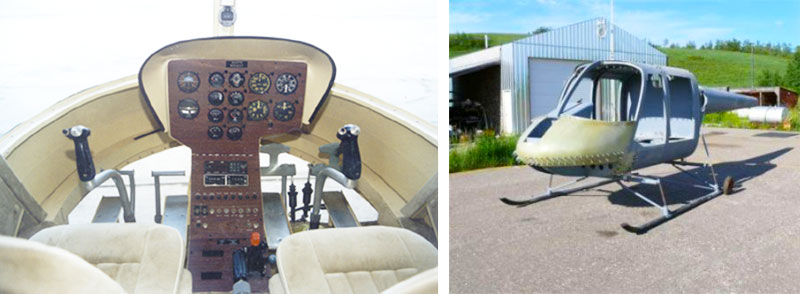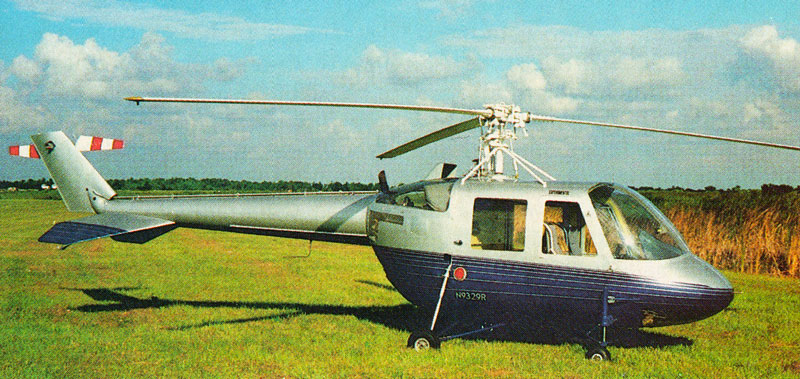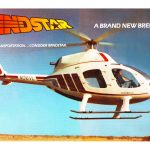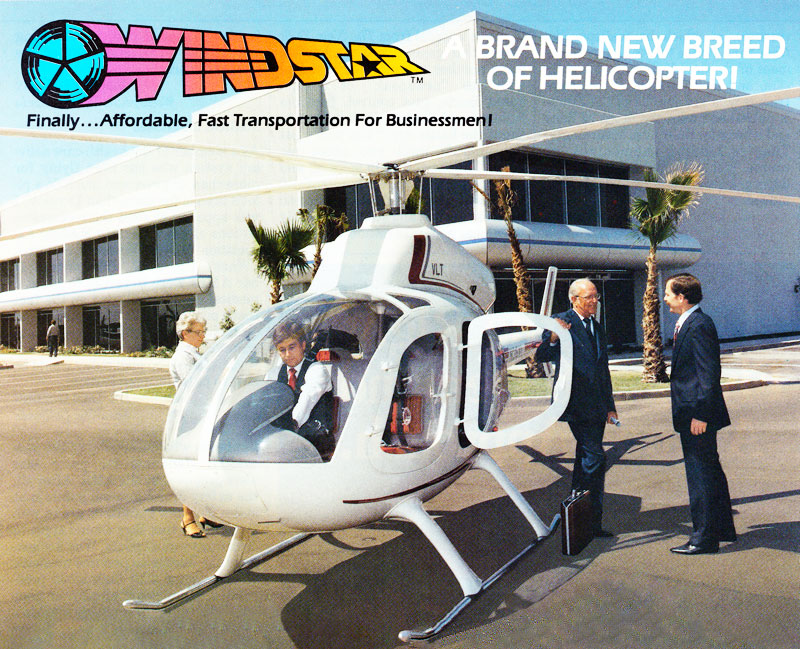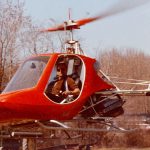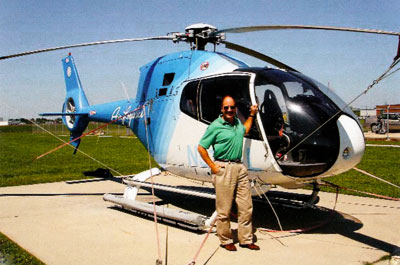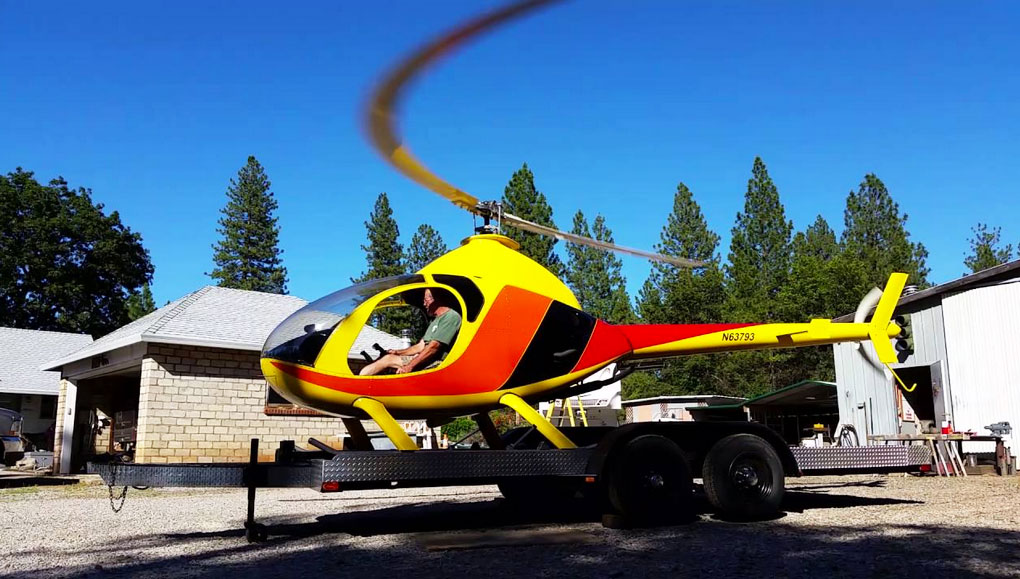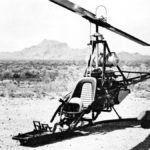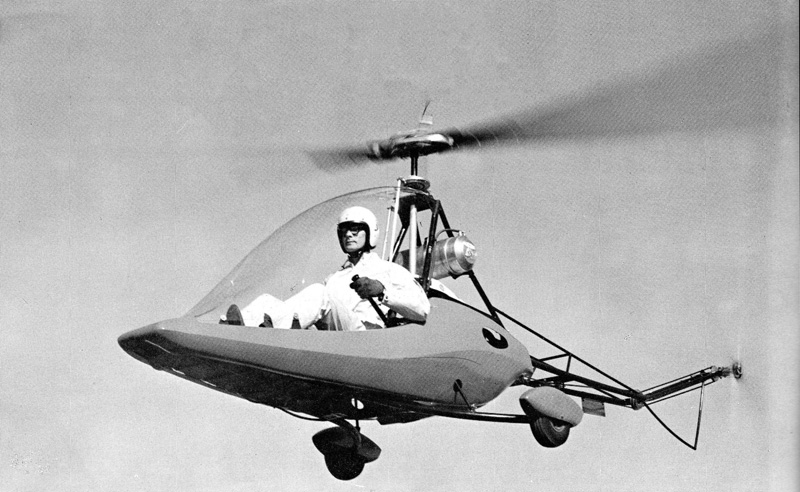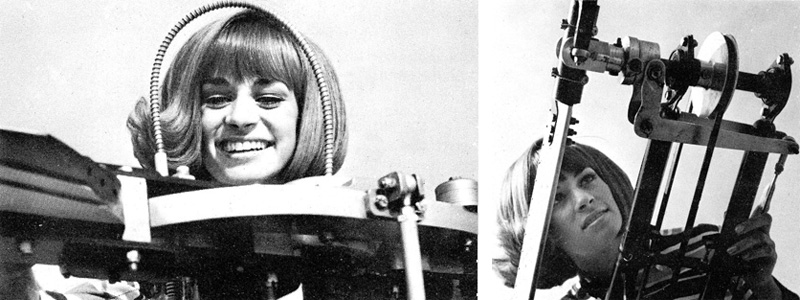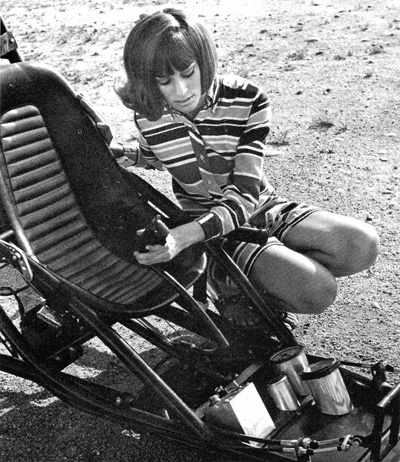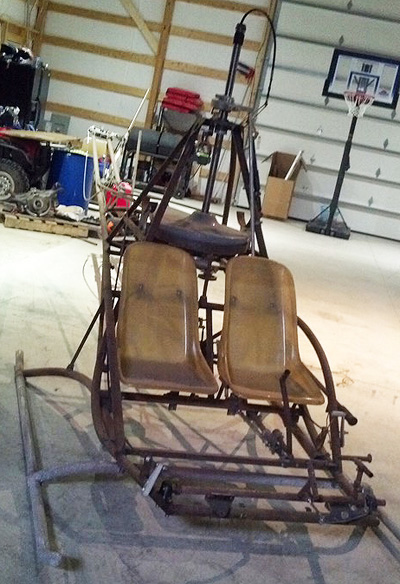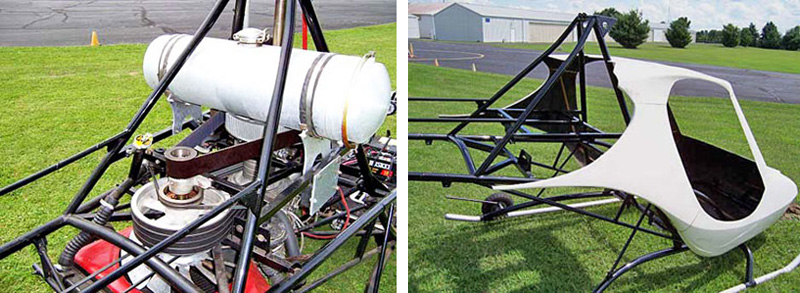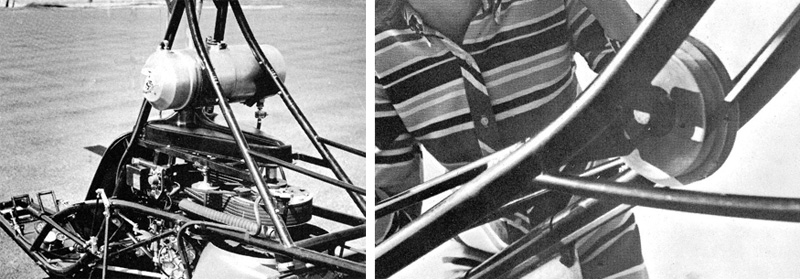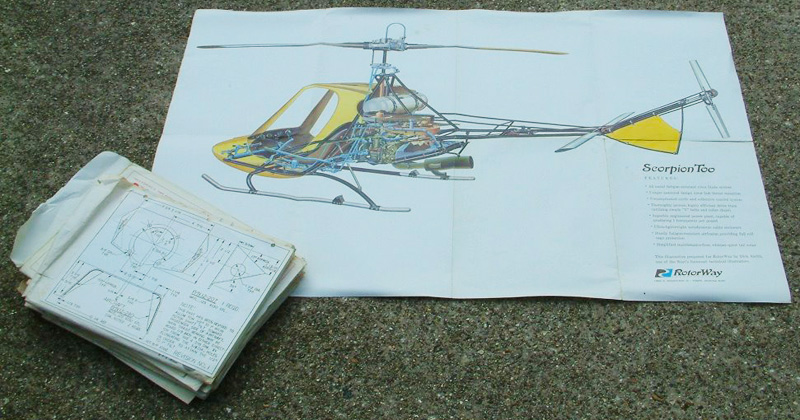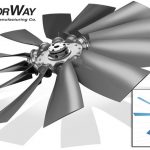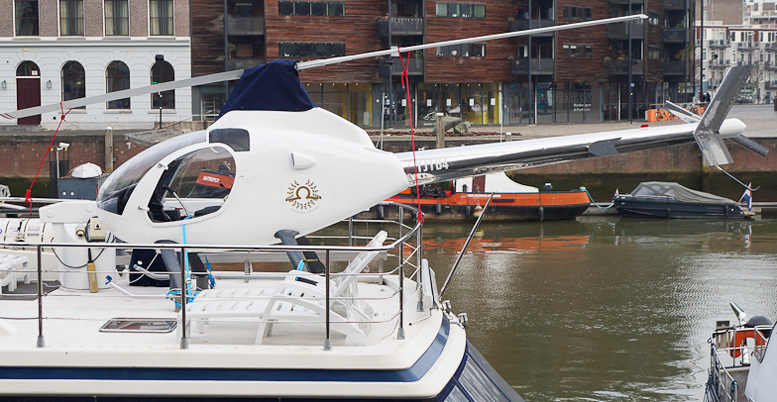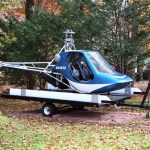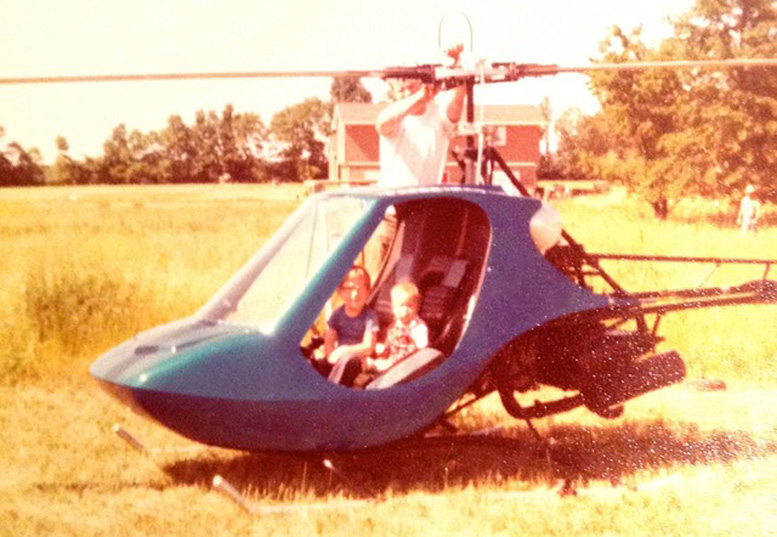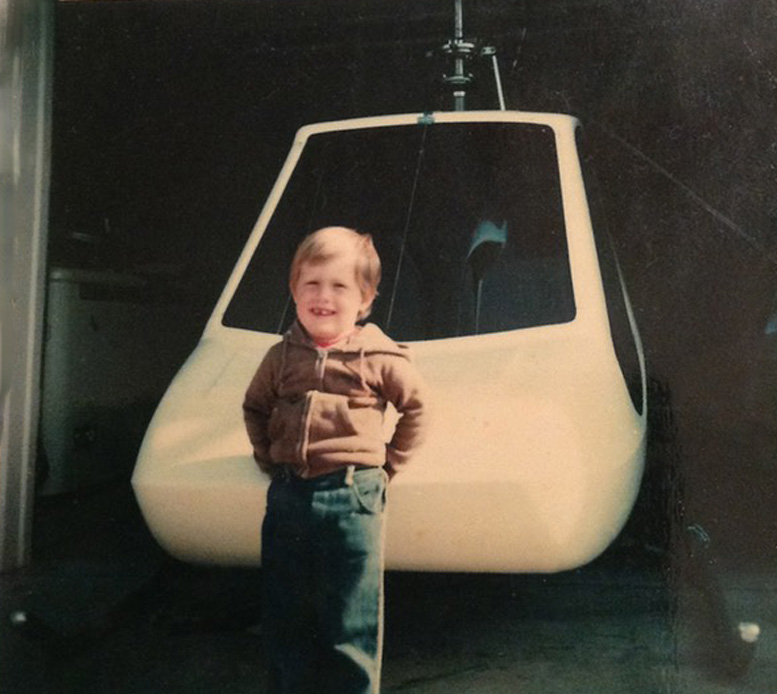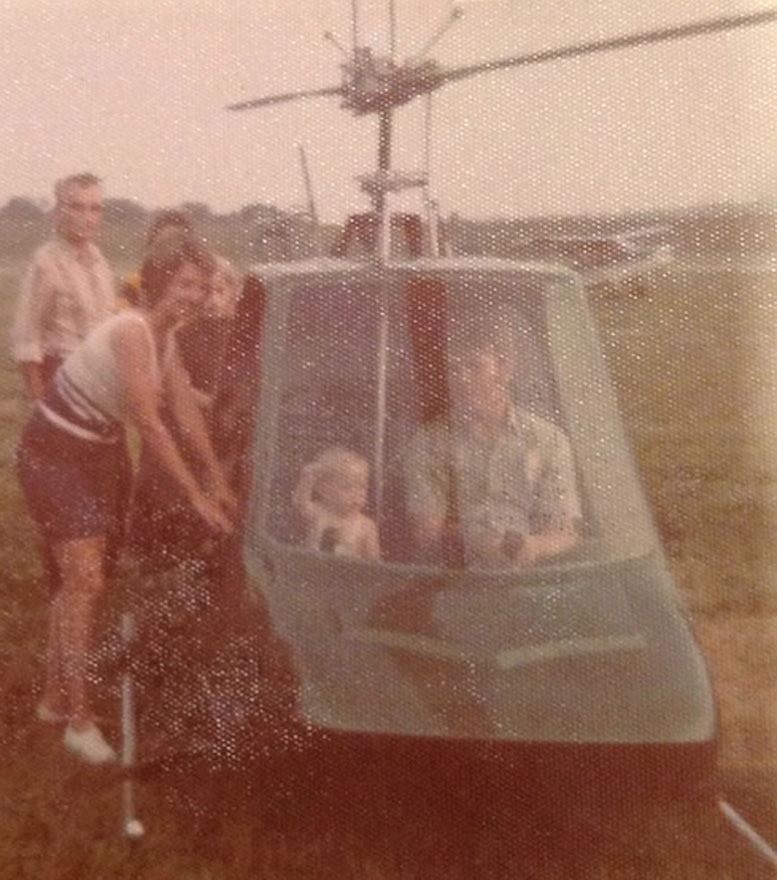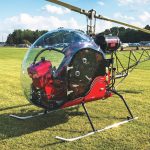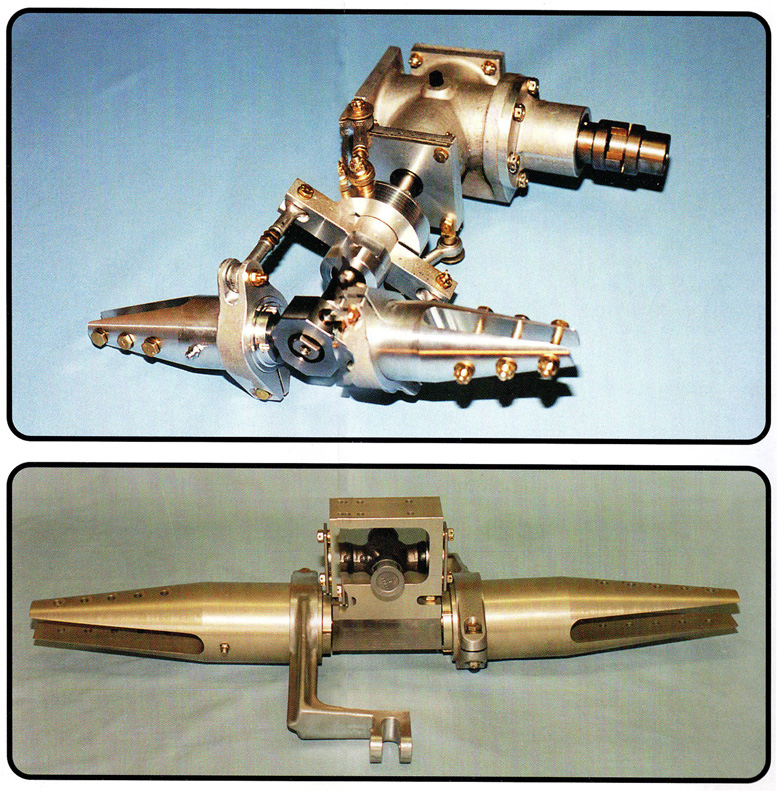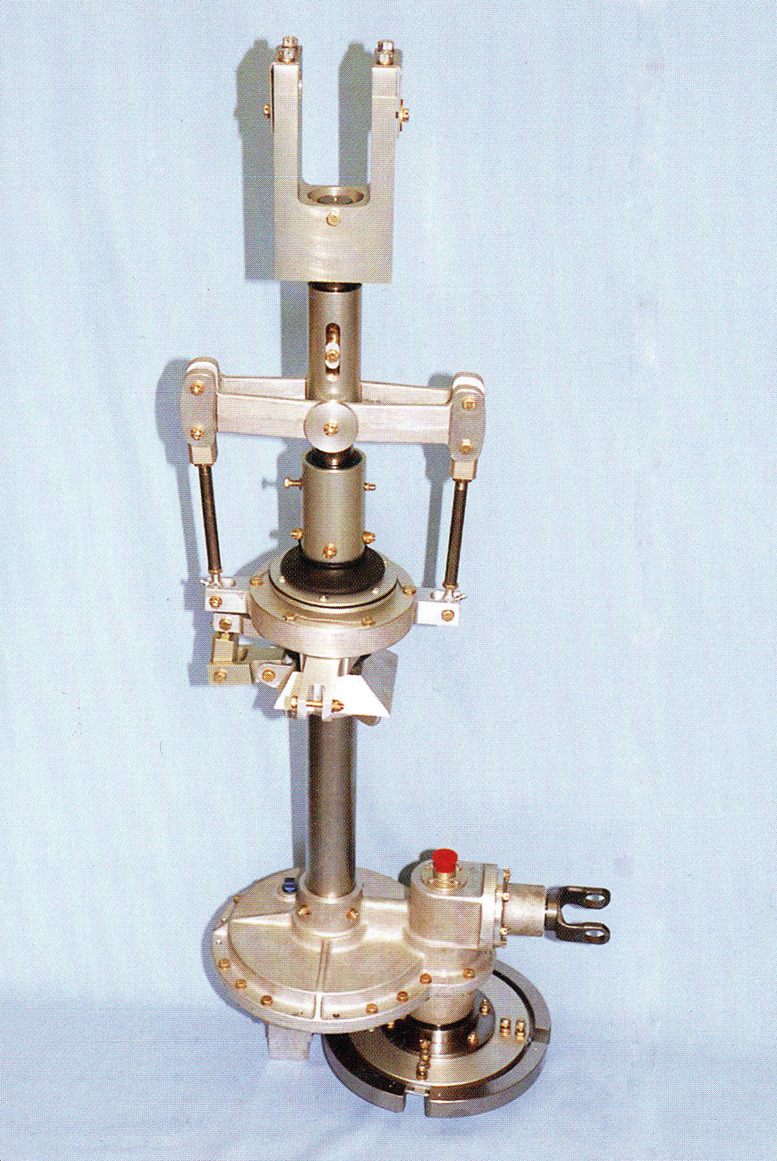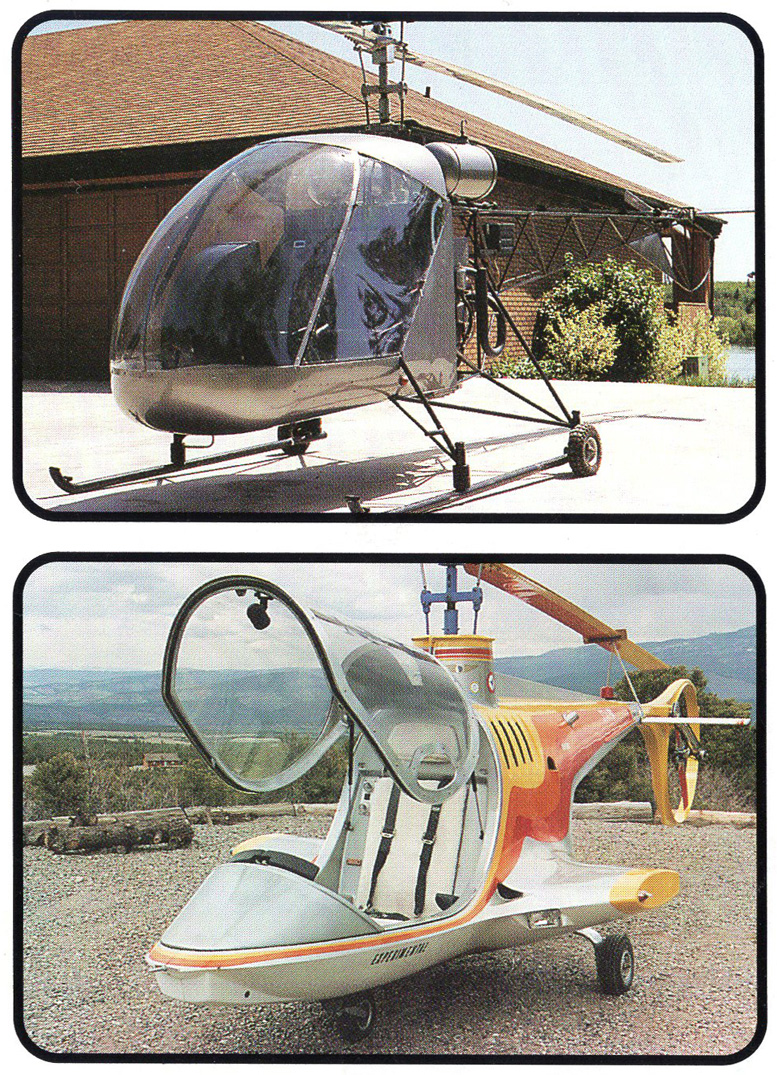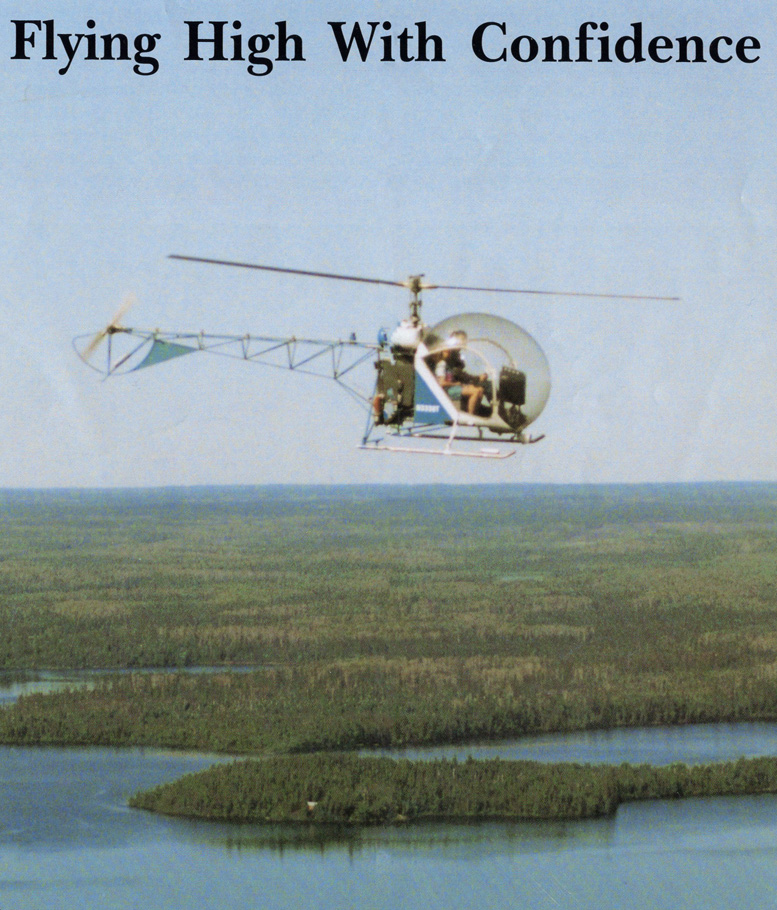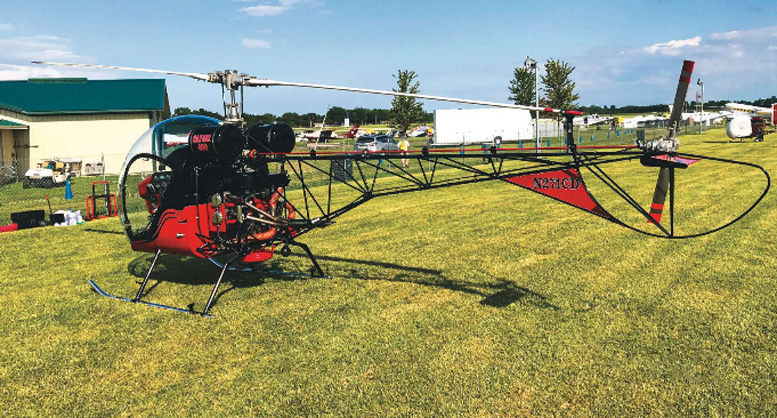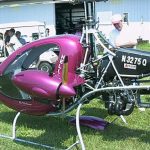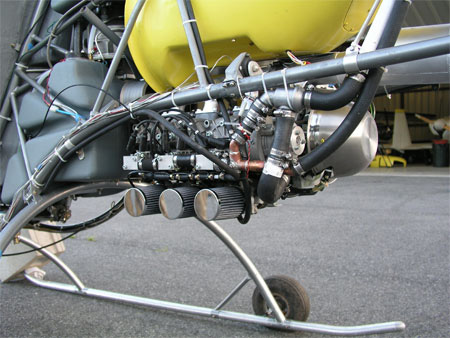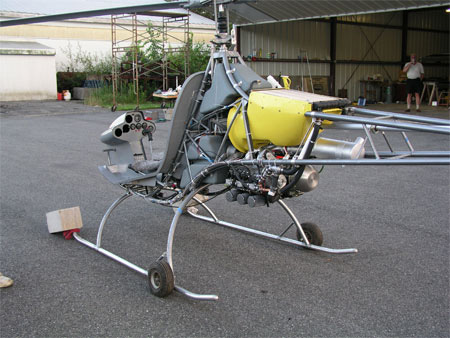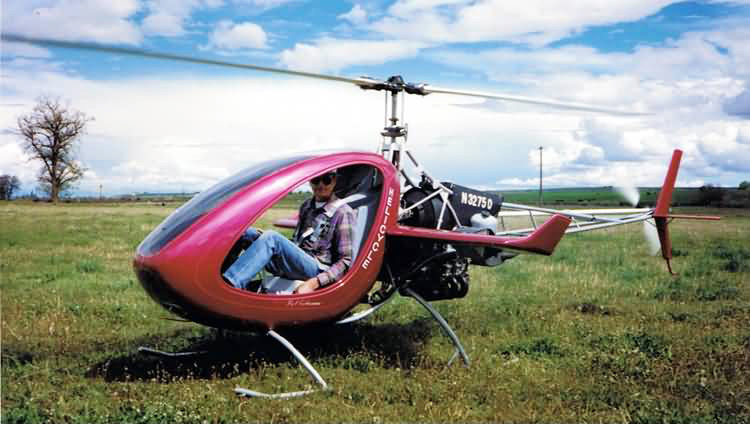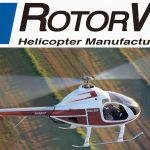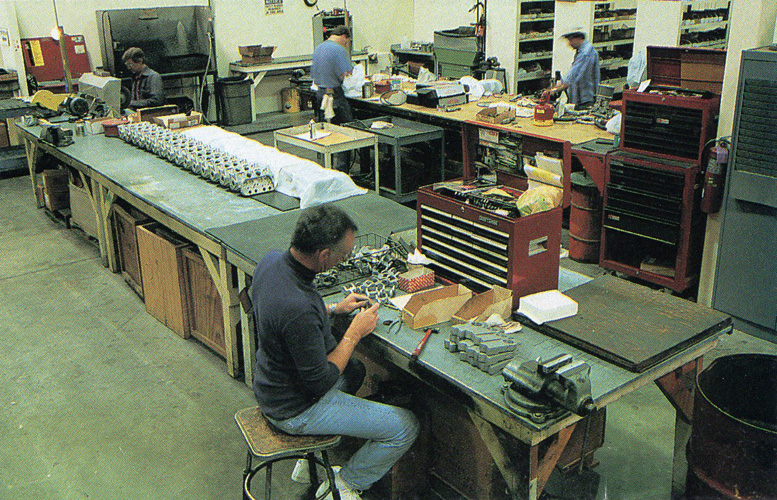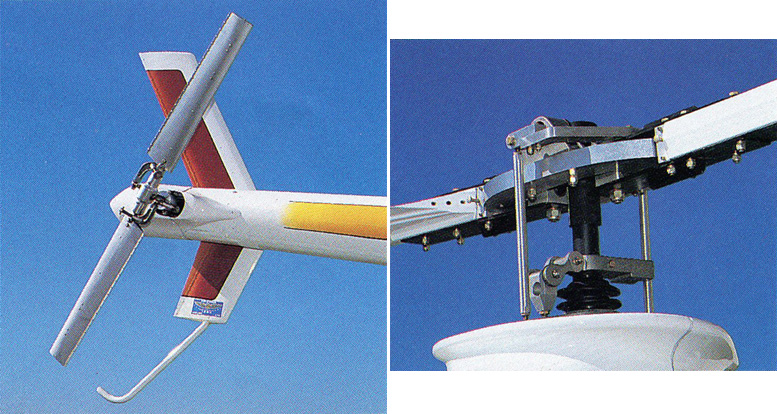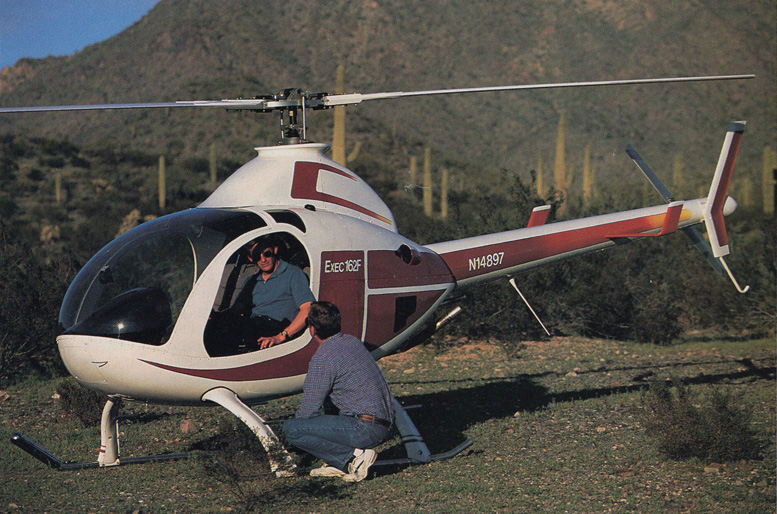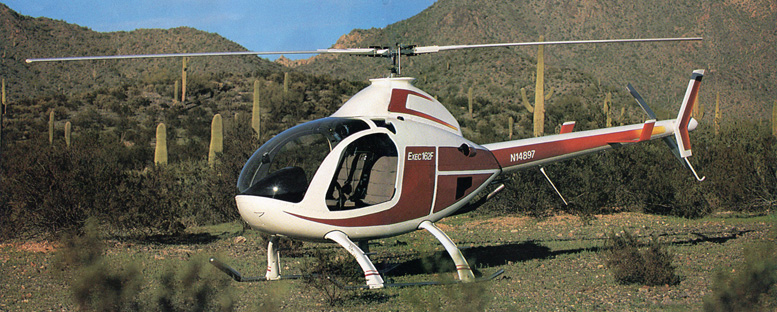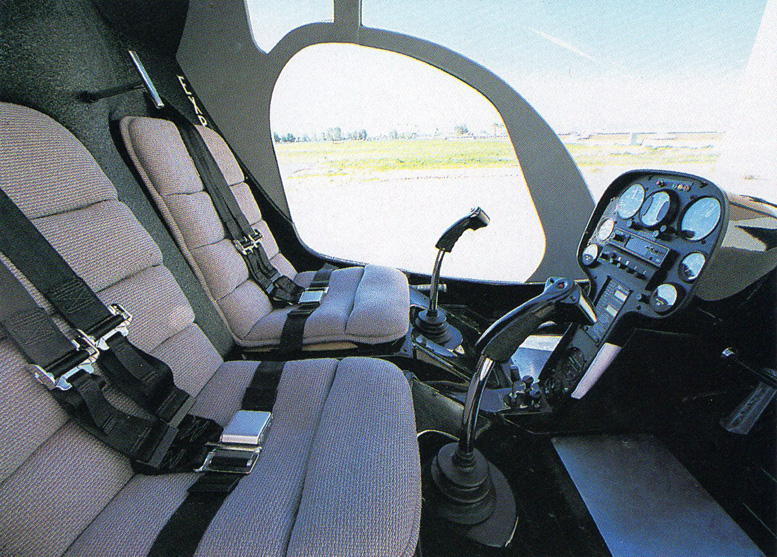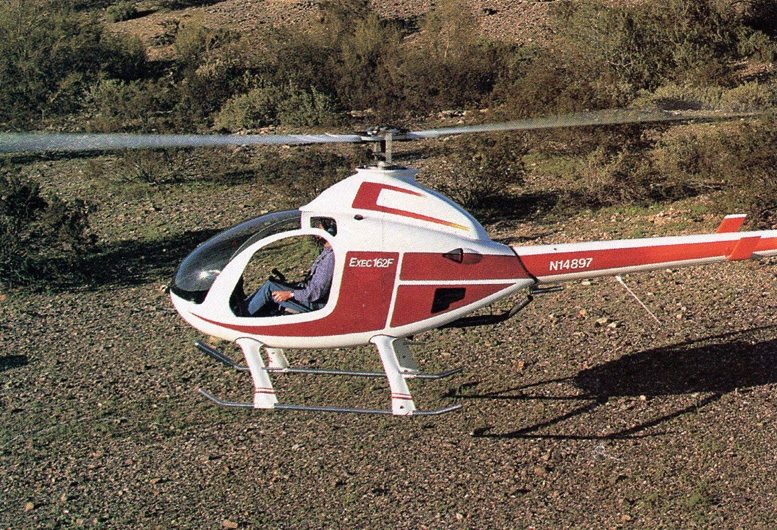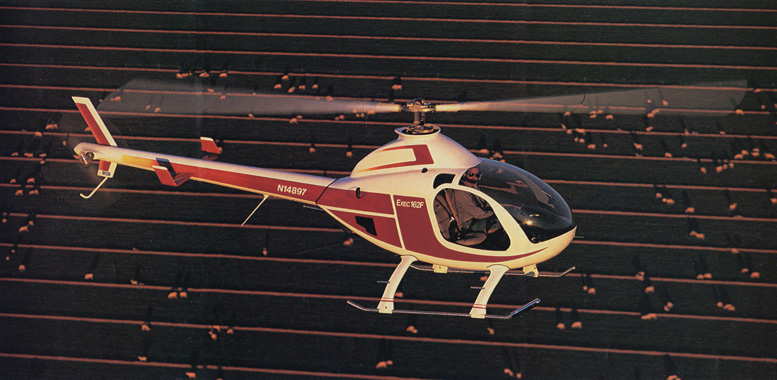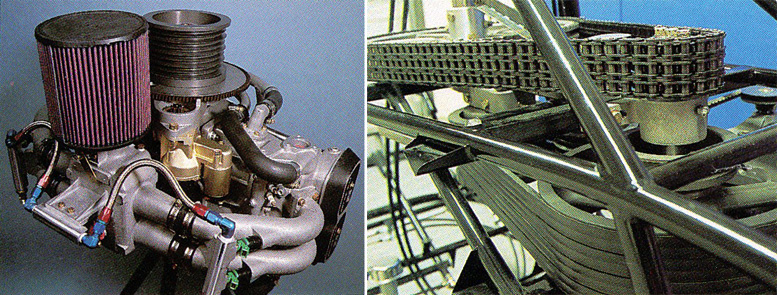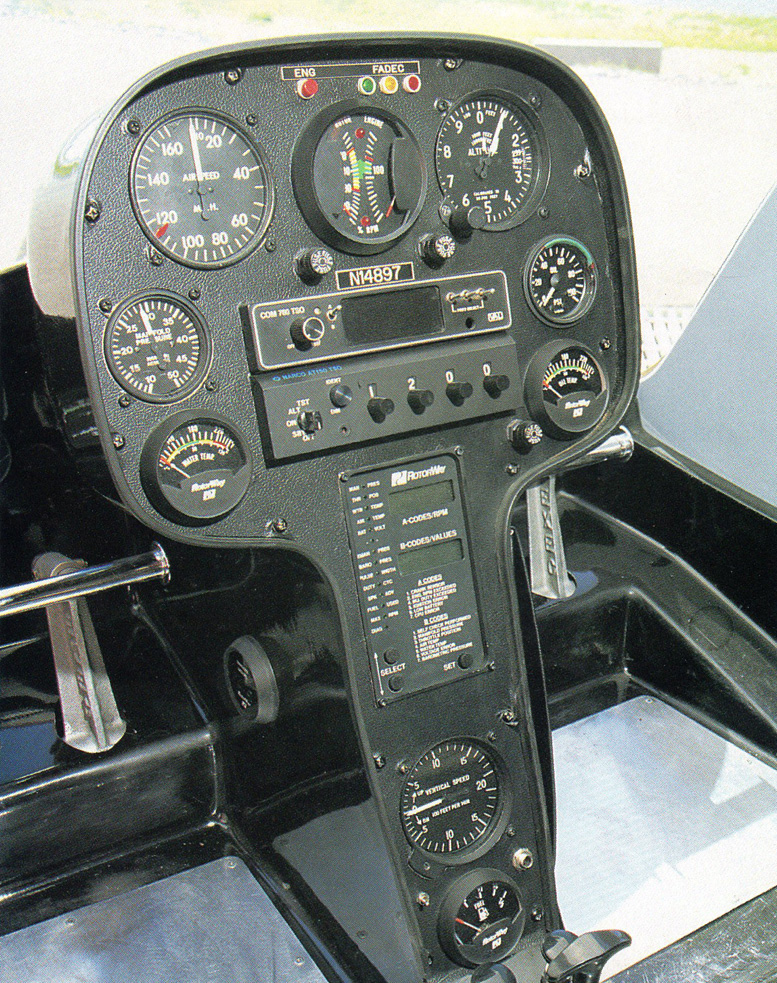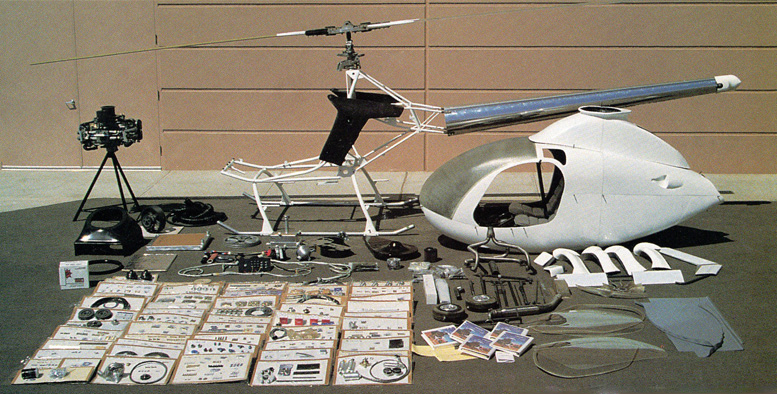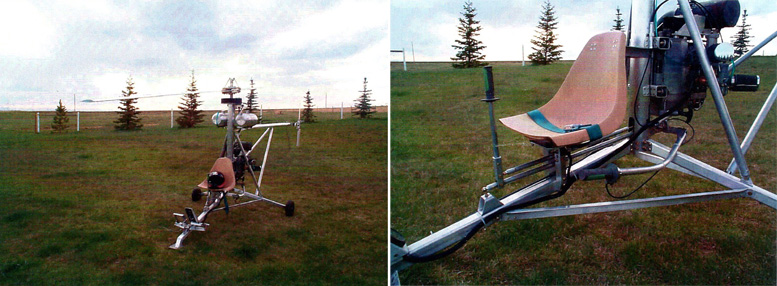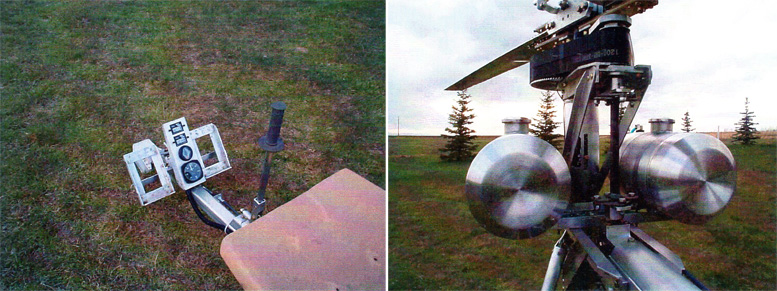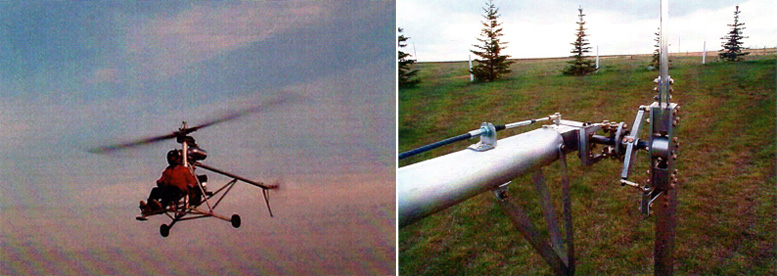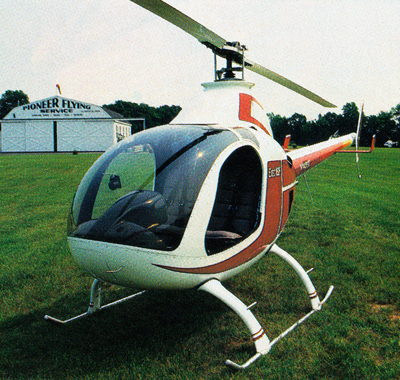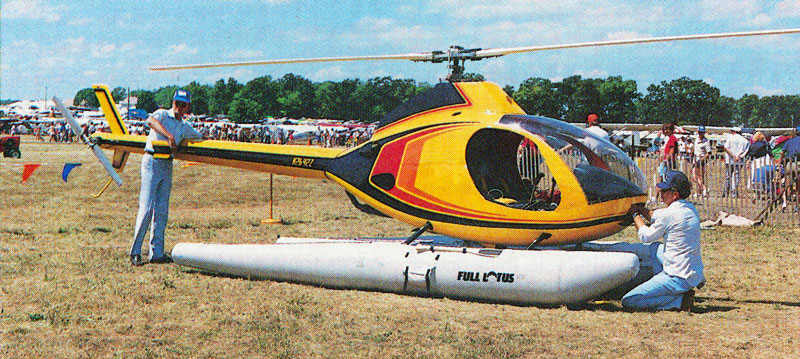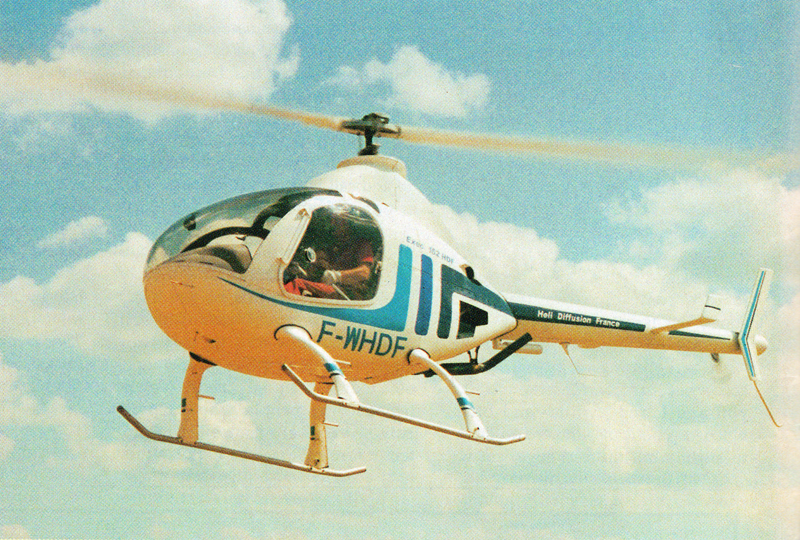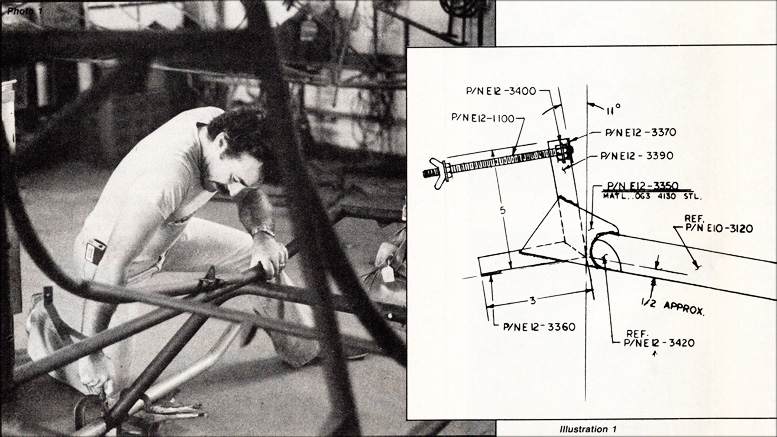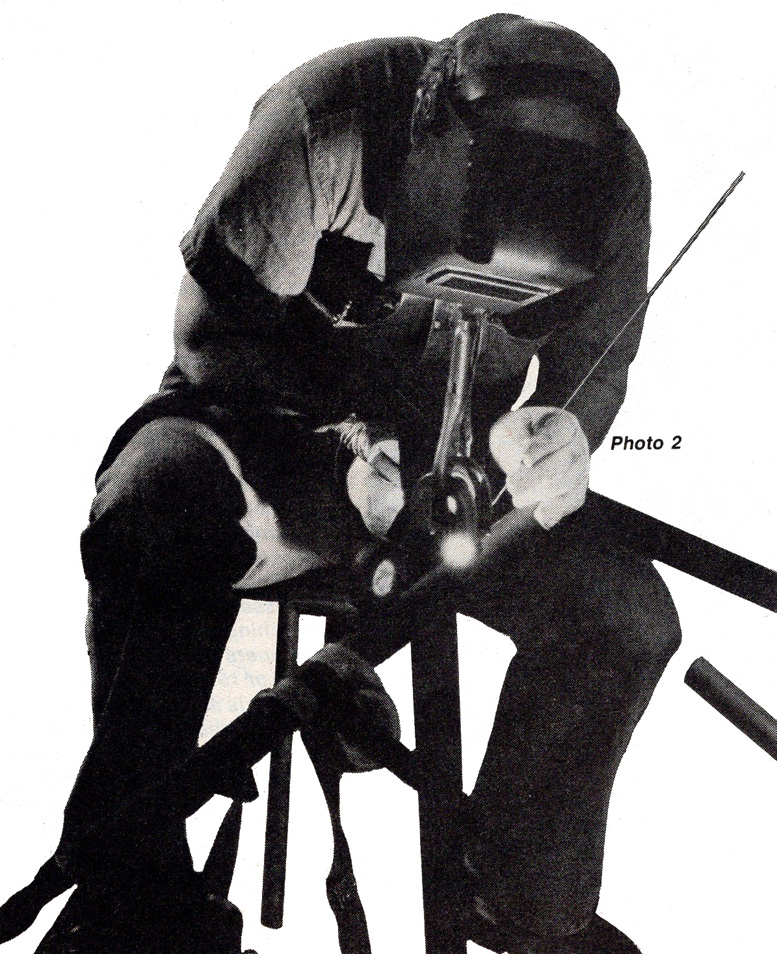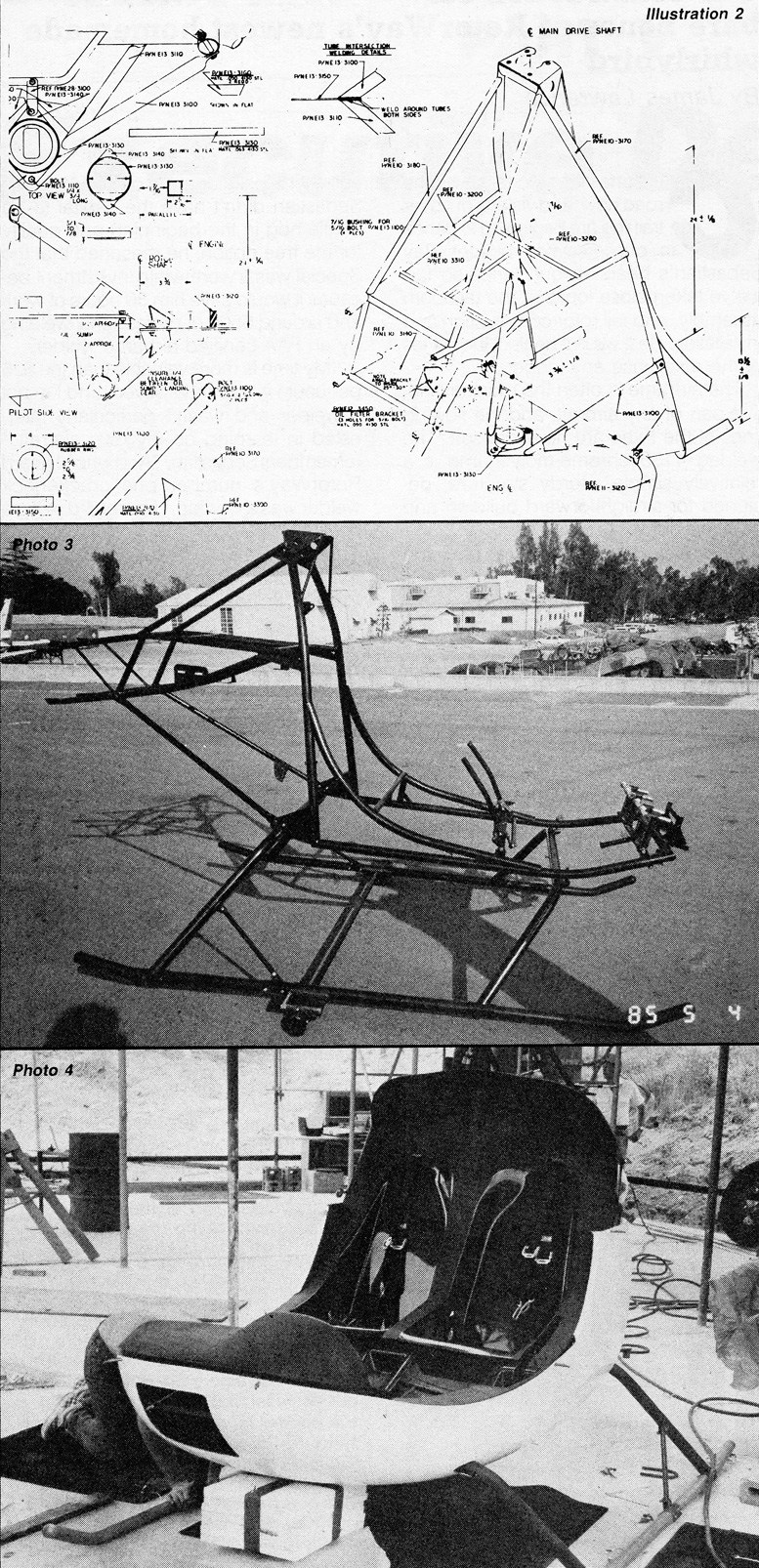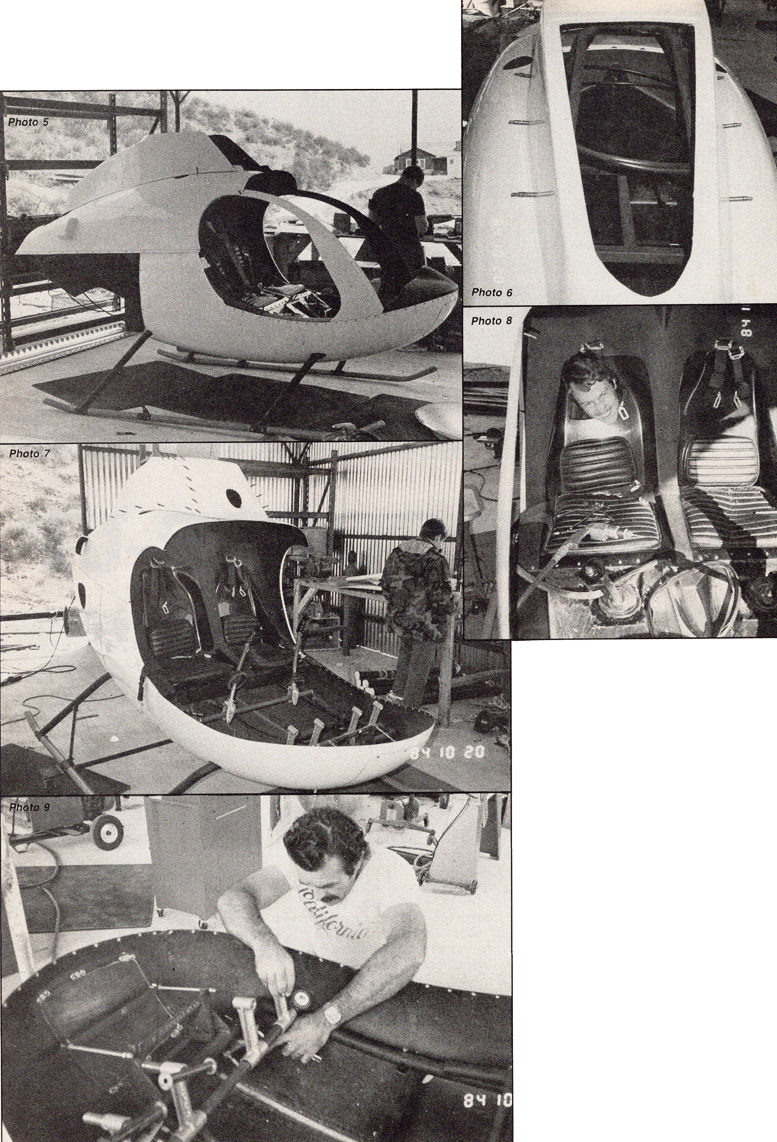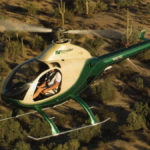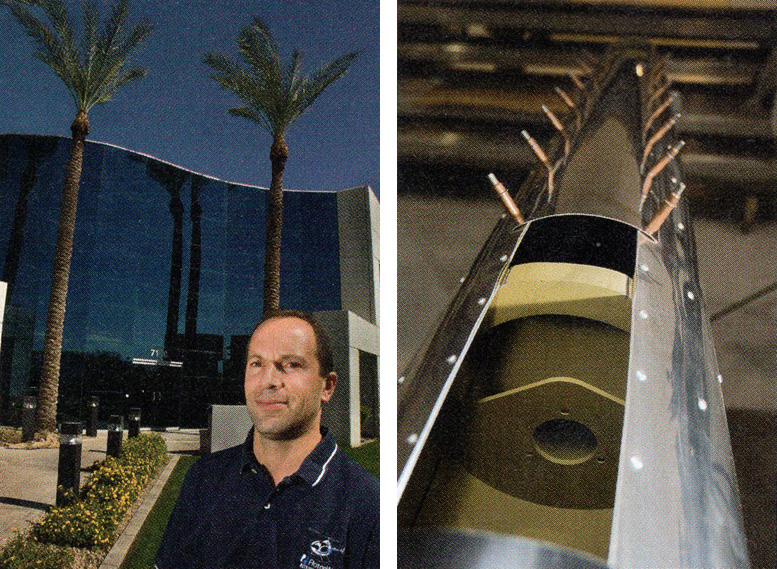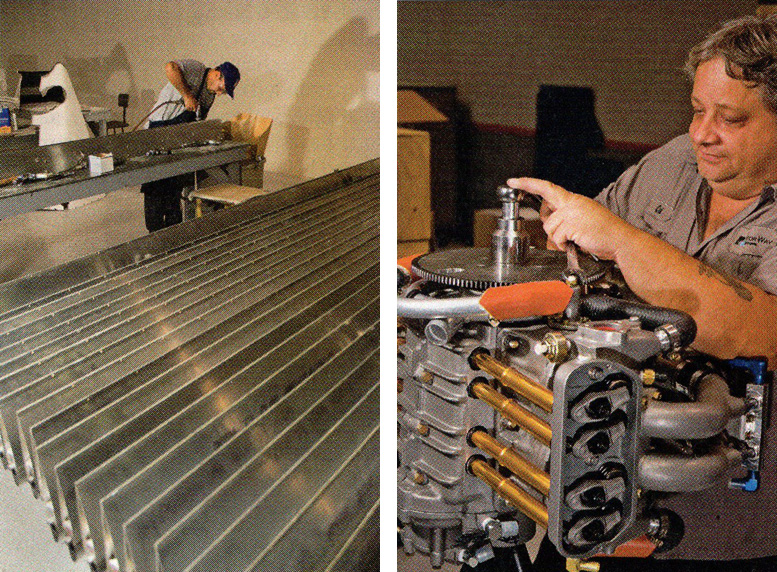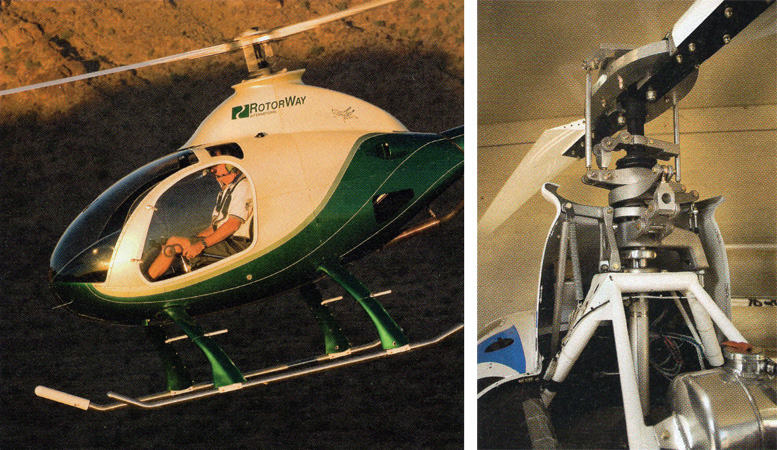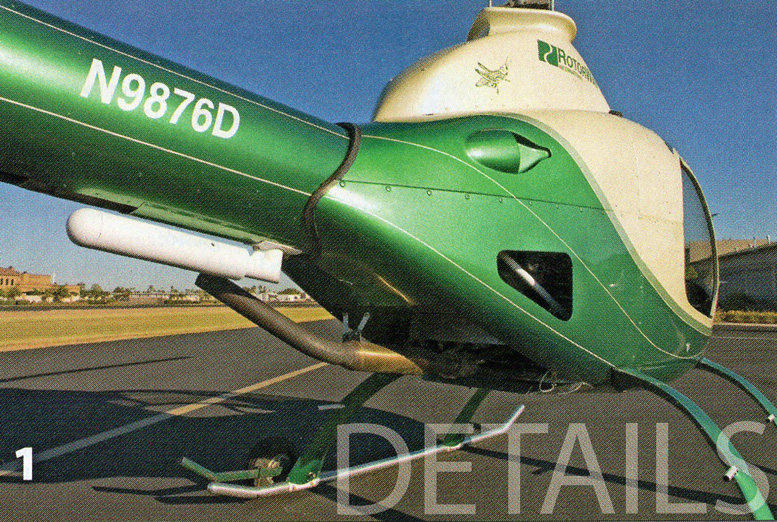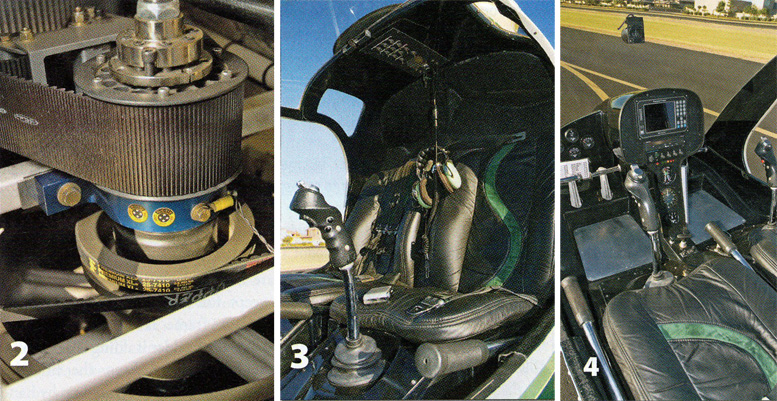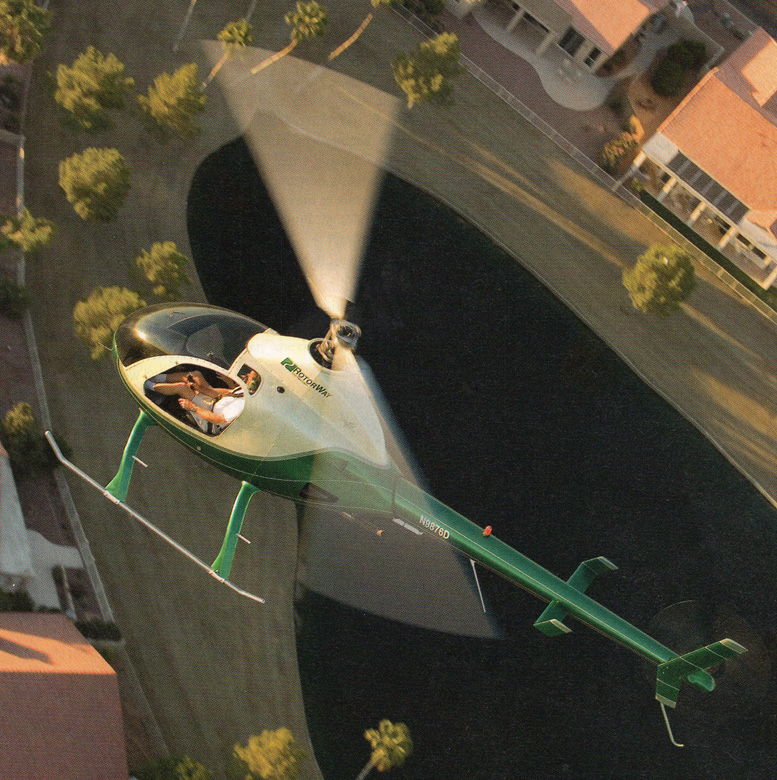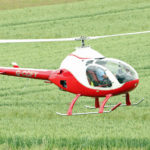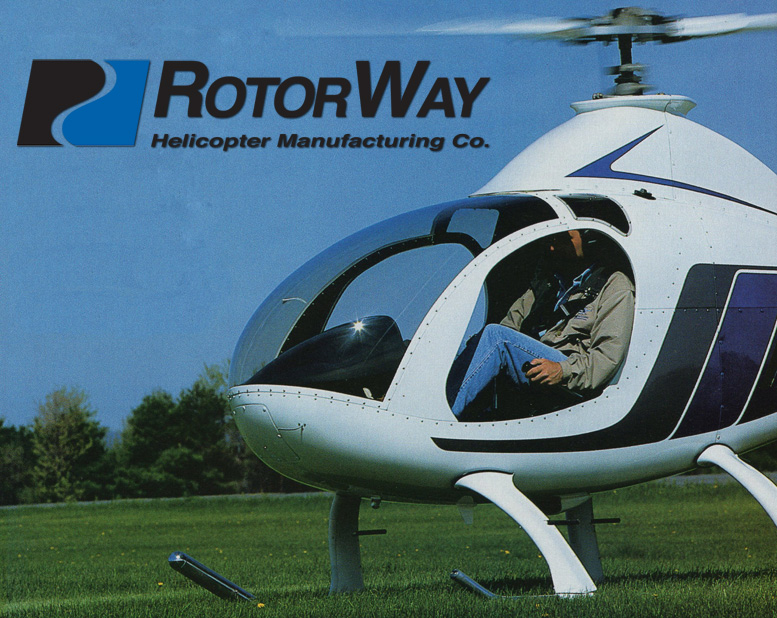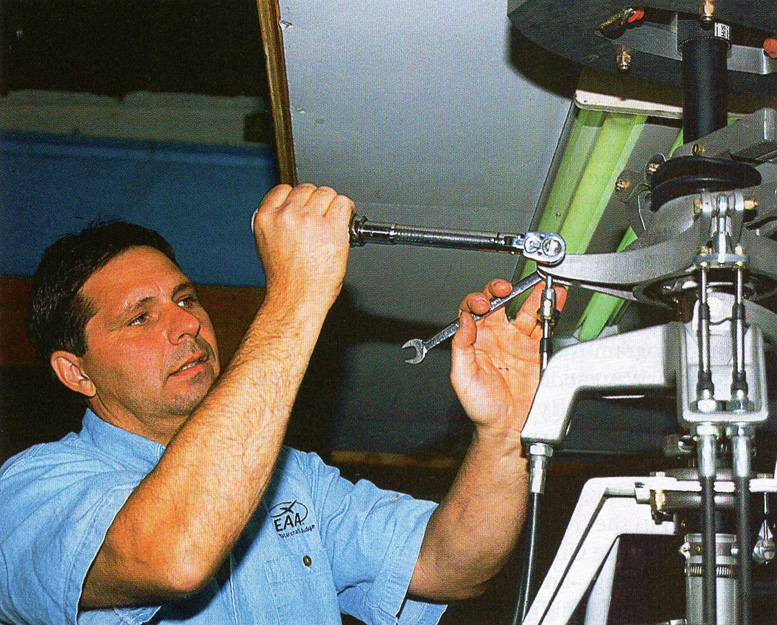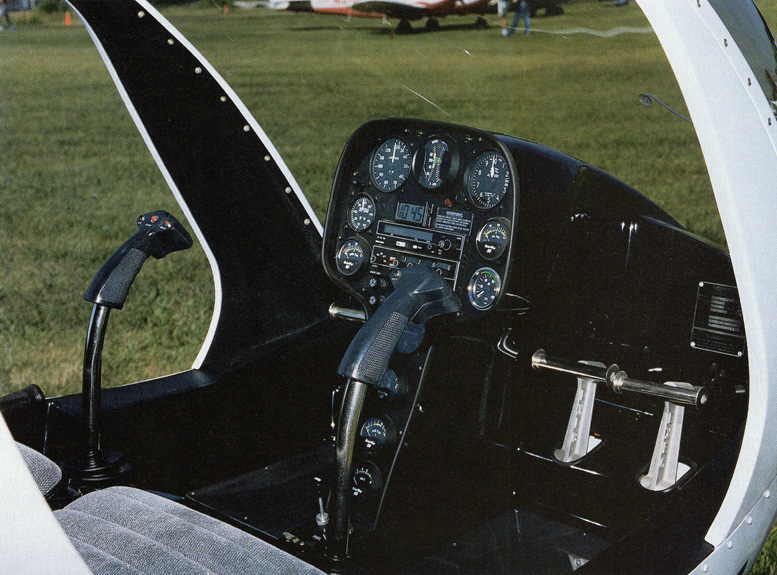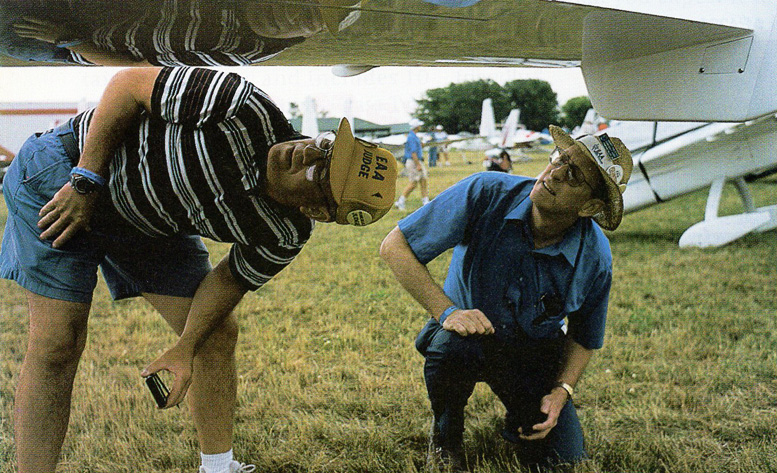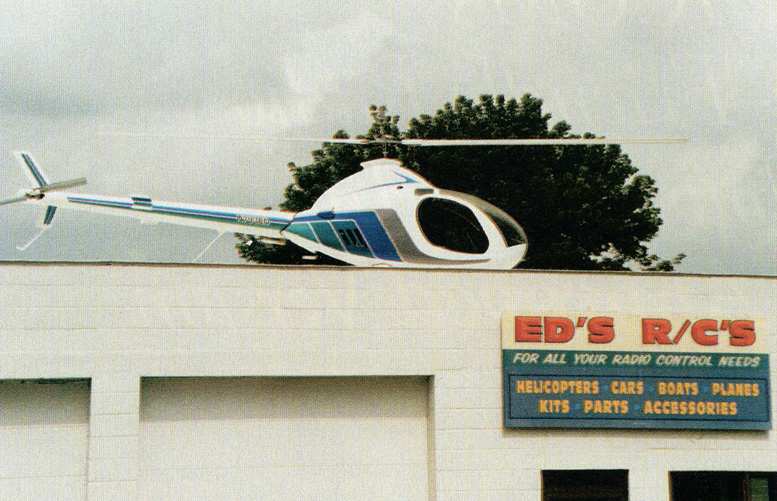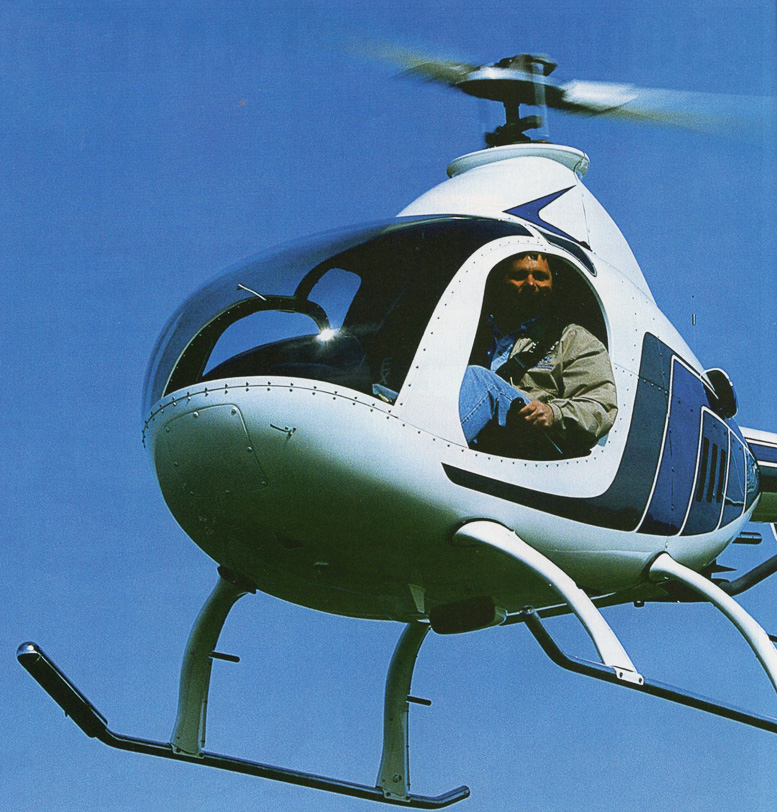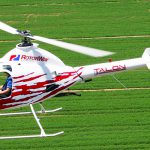
Rotorway Two Seat Exec Kit Helicopter
THE EXEC HELICOPTER TAKES SHAPE
In 1980, it was finally determined that a whole new design of the helicopter was needed, inside and out. An increasing number of customers were purchasing the helicopter for more than just weekend recreation. The more varied utility of this new kit demanded higher performance levels. That is how the Rotorway Exec Helicopter began.
Three years of research and development were undertaken to yield this new Rotorway Exec Helicopter design, but it proved to be well worth it, the end product setting higher standards than ever before for kit aircraft, both fixed-wing and helicopter designs.

As with any new design aircraft, there were areas of substantial improvement as well as unanticipated difficulties. Less than perfect aerodynamics and a tendency to overheat were some of the issues that were later resolved.
One of the most significant improvements with this model was the elastomeric main rotor system, which improved the “workhorse” capability of the Rotorway Exec Helicopter.
The well-proven elastomeric technology had been used in commercial helicopters up to that time, but would now be adapted to a kit helicopter. The term “elastomeric bearing” refers to a bonded rubber type bearing in which alternate thin layers of rubber and brass shims are bonded together in a pack much resembling a stack of thin washers.
This “sandwich” absorbs the pressures of the main rotorblades centrifugal force and at the same time, due to the flexibility of the rubber, the feathering motion of the blade can occur at a very rapid rate with very low cycling loads being applied to the blade pitch horns. The Rotorway Exec Helicopter with the RW 152 engine carried a pilot and passenger load of 380 pounds and had a normal cruise of 95mph, with maximum speed of 115 mph.
VIDEO: Timelapse Rotorway Exec Helicopter Build
LAST DAYS OF ROTORWAY AIRCRAFT
With design concepts evolving again in the late 80’s, RotorWay created another new model named the Elete, a larger, attractive two-place helicopter which showed a lot of promise, yet presented once more the numerous difficulties associated with a new model.
Rotorway announces ELETE kit helicopter
The new RotorWay ELETE incorporates numerous new features four specific areas Those include aerodynamic improvements, an extended component life and power plant reliably improvements, and some very important builder assist construction improvements.
The prime purpose of the ELETE is speed. In order to increase speed, one of two things must happen. Either you increase power or decrease drag. In our case, it was important we achieve a significant drag reduction, otherwise the result would be a significant increase in cost.
The Elete had an RW 152, water-cooled, dual electronic, 4 stroke engine that provided 152 horsepower with a pilot and passenger payload of 400 pounds. Normal cruise was 113 mph with maximum airspeed of 130 mph.
The aerodynamic improvements of the ELETE are outlined here as: two piece windscreen, cabin airflow separator, skid fairings, swashplate fairing, laminar flow air dam, NACA air ducts, NACA engine air inlet, streamlined radiator exhaust, drag reducing muffler fairing, pitch & yaw stabilization improvements.
Cabin comfort features include: improved vision, cabin air flush duct, outside air ON/OFF switch, cabin heat vents, removable cabin engine heat deflector.
There was also even a prototype development of a four place kit helicopter called the Rotorway Windstar helicopter that simply proved to be far too costly for the kit marketplace.
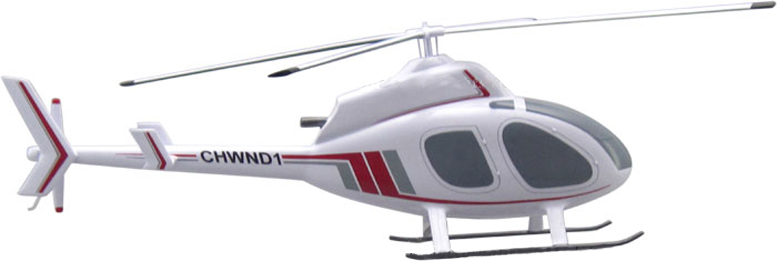
The development costs for further research and testing were also running more expensive than a small company could absorb and the project was soon dropped.

Chopr1 wrote:
Just happened to come across this site-very interesting. I was hired in 1981 to work for B.J. Schram in the R&D dept. of VLT. Windstar was just on the ground floor when I started. B.J. of course owned Rotorway aircraft but had a idea to build a 4 place commercial piston powered helicopter, thus, came the company VLT. Long story short – all parts and components were built in house-engine, body, gear boxes-blades-etc.

He owned his own metal foundry so we could cast all our own parts – aluminum, stainless steel, copper, etc. The engine was a 6 cylinder, fuel injected, turbo charged, water cooled type. The prototype helicopter was built and flying – this is the one you see in pictures.
In about 1988 the prototype had a incident at Chandler field in Chandler, AZ. that was also a bad time for the economy and money was tight, thus ended Windstar project. I then was moved back to Rotorway to build a replacement for the experimental built Exec helicopter.
This is what is know as the “Elete” One prototype built and flying “factory ship” and two kits were made and shipped before the plant had to close and was later bought by English man John Netherwood. These are quick thoughts I had – sorry for length- lots of history there.
David Hillberg wrote:
I called and tried to acquire the wind star from the ones who now have it, or the one, I think it’s up in Hisperia somewhere now, when Don and I worked on it for the five firemen they were too busy looting the pot they made.
We had it almost done when they pulled the plug, we removed 680 pounds of worthless crap from the airframe, engine (nice workmanship for a BMW styled engine) PAL system, hydraulic pumps, coolers, radiator, the crappy fuel system, flight controls and soon the doors that weighed about twenty pounds each.

We installed a flat floor with a bladder underneath, crash worthy pilots seat, (it could now seat six if need be, or a stretcher with aft entry doors) a mock up push pull tube flight control was installed, from what I heard one main rotor blade was dissected (mistake of a fool who did it) and they have no clue of what to do or sell it.

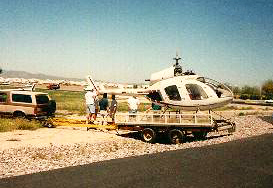
I figure the crashed one we used as a mock up and the flying intended one are now lawn art, they just jack everyone around who shows the least bit interest in it. I think that they bought if for 90 thousand or put that amount into it?
With all the engineering data lost (some of it had errors) and the tooling in it’s past condition as observed was junk, a lot of work will be needed to certify the new design Don and I did, (the Push-Pull cables prevented the civil certification of the aircraft).

I would like to see it fly yet the owners think otherwise, sad, it is a sexy ship. The revised powerplant would be an off the shelf injected 435 Lycoming lest anyone has a spare C20 to loan…there’s a video of it in the air and it showed the strain of it’s rotundness….I think it would have flown just fine….
Don Hillberg wrote:
That’s me in that photo ,Lenny Cuzmal, James Gruver & A RotorWay guy, Around 1995? or so we picked it up to convert it to an Allison 250 c20 and remove the engine as the tooling was gone, (German designer possible Porsche modified power plant) VLT? Lenny ran out of $$$$ project sits last I knew at French Valley Air Port California.

What took you so long? The Wind Star had a flap pitch coupling effect that required stiffening & repositioning the pitch control link attached on the blades but it was all workable. If they used a Certified engine & conventional controls, it would be a go for US Certification. (I have some data & copies of the FAA directorate Dallas Fort Worth on the issues.)

COURTESY: http://126840.activeboard.com/t48658247/windstar-helicopter-ad-1970s/
VIDEO: Rotorway TALON 600
After selling three Elete helicopters, the company finally succumbed to financial challenges and was soon purchased by a former customer, John Netherwood, a businessman from England. Netherwood recognized the design hurdles of the Elete and promptly set out to address making the proven Exec model a better aircraft for the new company of RotorWay International to sell.
THE EXEC 90 AND ROTORWAY INTERNATIONAL PREMIERE
The Exec was reviewed from top to bottom. Any and all suggestions were considered, evaluated and many implemented. Extensive redesigning was done and when all was complete, 21 items were changed or improved including the aerodynamics, drive train, stability and power.
The engine was once more a primary area of improvement, a task made even easier by the fact that RotorWay had been engineering and manufacturing their own engine for years by this time.
The RI 162 cubic inch engine was specifically designed for rotorcraft flight and possessed an incredibly light weight to horsepower ratio. Extended life limits were added to the chains, belts, rotor system and asymmetrical blades.
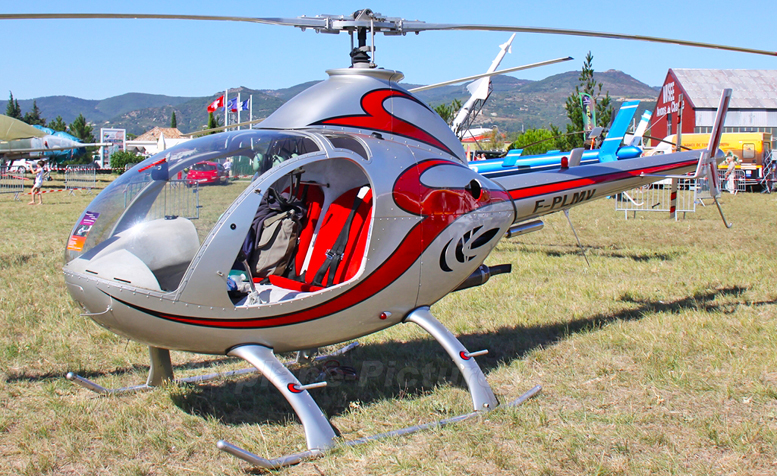
Improvements were made in every aspect of the aircraft including the method of packing and organizing the kit, the manuals, and the customer service program to assist the builder with technical information. Many critical systems were then assembled by RotorWay itself, almost all of the fabrication completed for the builder. All of the welding was now done at the factory as well.
The rotor blades required little more than finishing touches. The tailboom had been formed and riveted and ready for inspection covers to be fitted, then mounted on the airframe. The wiring harness was assembled and tested, coming ready for installation.
The Exec 90 was the only piston-powered helicopter at the time to utilize an asymmetrical airfoil for improved autorotation characteristics and safety. The Exec 90 also utilized a unique drive system, eliminating an expensive transmission, metal chip detectors and possible in-flight failures.
With all of this in place, the expected build time with the standard kit was about 500 hours. A quick build kit was soon offered, cutting that time nearly in half. Eventually, the quick build kit became the only way in which to purchase the helicopter. Pilot and passenger load was 400 pounds with a normal cruise of 95 mph and a maximum airspeed of 115 mph.
JUST KEPT GETTING BETTER AND BETTER
In 1994, the company took a hard look at the carbureted engine used in the Exec 90 and knew they could do better. A fuel injection system with electronic ignition and a computer control (FADEC) was developed. Along with numerous other improvements, the Exec 162F was born.
This latest model represents the culmination of over 30 years of research, development, testing, progress and proven performance. It is the number one choice in the kit helicopter marketplace, having earned that spot by providing a safe, reliable, enduring way to enjoy rotorcraft flight. In 1996, Netherwood opted to retire and go home to England.
Recognizing an opportunity, the employees of the company bought RotorWay International through an Employee Stock Ownership Plan (or ESOP), making the company one of only a handful of kit manufacturers with any kind of employee ownership at all.
Improvements continue to take place, namely in the capabilities of the FADEC system (Fully Automated Digital Electronic Control) of the Exec 162F. Using the latest online technology, the customer is able to connect the FADEC system on his helicopter to a laptop and modem and then directly to the factory in Arizona.
From Arizona, RotorWay technicians can diagnose, tune and adjust FADEC and engine functions for a customer located anywhere in the world. This is a technological development unheard of in the experimental category and practiced only among a few of the certified helicopter companies.
RotorWay International was also the first to provide a complete and detailed construction and maintenance video series for the amateur builder in order to assure the proper construction and maintenance of each customer’s aircraft. These series have met with great reviews by aviation editors and customers alike.
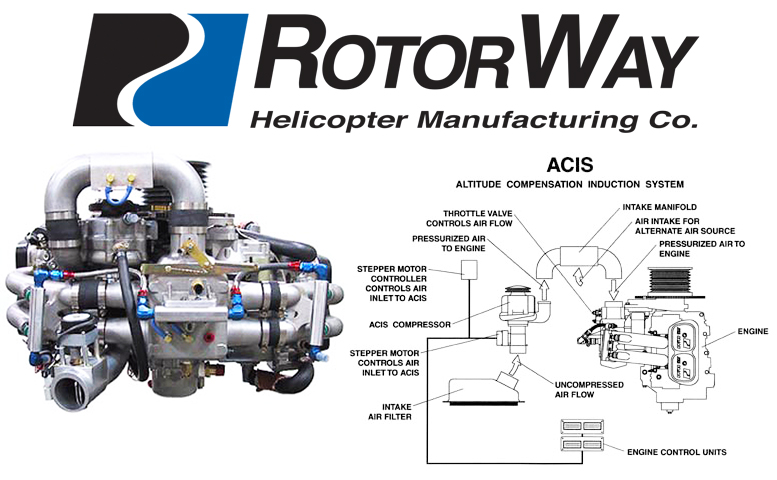
One of the most recent developments also includes the ACIS. This Altitude Compensation Induction System is lightweight and efficient, allowing the RI 162F engine to maintain standard sea level performance up to higher density altitude than ever before. By not demanding any more power at altitude than is produced at sea level, the life of the engine is unaffected, while its performance at higher altitude is enhanced.
Utilizing a belt-driven supercharger concept, cooler outside air is compressed to a set pressure. This method does away with the hotter intake air and lag associated with a turbocharger. The pressurized air from the ACIS is made available to the intake system through the throttle valve. Manifold pressure is limited only by the amount of compressed air available.
Unique to this system is the continued redundancy of the RI 162F engine. The ACIS uses an electro-mechanical inlet gate control and is connected to the FADEC (Fully Automated Digital Electronic Control) which monitors and maintains proper limits. This follows RotorWay’s goal to provide a failsafe system for the Exec162F. The ACIS system is the result of hundreds of hours of research and successful testing, meeting strict standards set by RotorWay International for all new products.
ROTORWAY INDUSTRY RECOGNITION
Helicopters from RotorWay International’s customers have won top EAA Awards almost every year since 1990. Prior to 1990, RotorWay Aircraft also had a continuous stream of awards for their helicopters. These awards not only recognized the individual customer’s workmanship but the quality and design of the helicopter as well.
In addition to these awards, RotorWay International has won other awards from EAA (Experimental Aviation Association) and HAI (Helicopter Association International) for technical advancements and development, particularly for the FADEC (Fully Automated Digital Electronic Control) system in the Exec 162F.
WHATS NEXT FOR ROTORWAY HELICOPTERS
In the RotorWay tradition, the company continues to conduct extensive research and development to bring about improvements to every aspect of the product. As a market leader, RotorWay is committed to providing the most proven, technologically advanced, reliable and safe helicopter kit in the industry. It is with this mission in mind that RotorWay International looks to the 21st century with great excitement about the things yet to come.
RotorWay 300T Eagle Helicopter

From Wikipedia, the free encyclopedia
The RotorWay 300T Eagle is an American helicopter that was under development by RotorWay International of Chandler, Arizona, in 2009-2011. The aircraft was intended to be certified and supplied as a complete ready-to-fly-aircraft for the flight training and aerial work markets.
The aircraft was announced at AirVenture 2009, with a first flight then predicted for 2010. The company started taking US$5,000 customer deposits at that time.
RotorWay 300T Eagle Helicopter Design and development
The 300T Eagle features a single main rotor, a two-seats-in side-by-side configuration enclosed cockpit with a windshield, skid-type landing gear and a 300 hp (224 kW) Rolls-Royce RR300-B1 turboshaft engine.
The aircraft has an empty weight of 950 lb (431 kg) and a gross weight of 2,050 lb (930 kg), giving a useful load of 1,100 lb (499 kg). With full fuel of 80 U.S. gallons (300 L; 67 imp gal) the payload is 580 lb (263 kg).
Since the initial announcement of the aircraft in 2009 no further information has been provided by the company and no announcement of a first flight has been made. The company’s webpage about the aircraft had been removed by the end of 2011 and the project may have been cancelled.
RotorWay 300T Eagle Helicopter Specifications (300T Eagle)
RotorWay 300T Eagle Helicopter General characteristics
-
Crew: one
-
Capacity: one passenger
-
Empty weight: 950 lb (431 kg)
-
Gross weight: 2,050 lb (930 kg)
-
Fuel capacity: 80 U.S. gallons (300 L; 67 imp gal)
-
Powerplant: 1 × Rolls-Royce RR300-B1 turboshaft aircraft engine, 300 hp (220 kW)
RotorWay 300T Eagle Helicopter Performance
-
Cruise speed: 127 mph; 110 kn (204 km/h)
-
Endurance: 2:30
-
Service ceiling: 13,000 ft (4,000 m)
-
Rate of climb: 1,600 ft/min (8 m/s)
Announcing the new RotorWay RW7 Helicopter
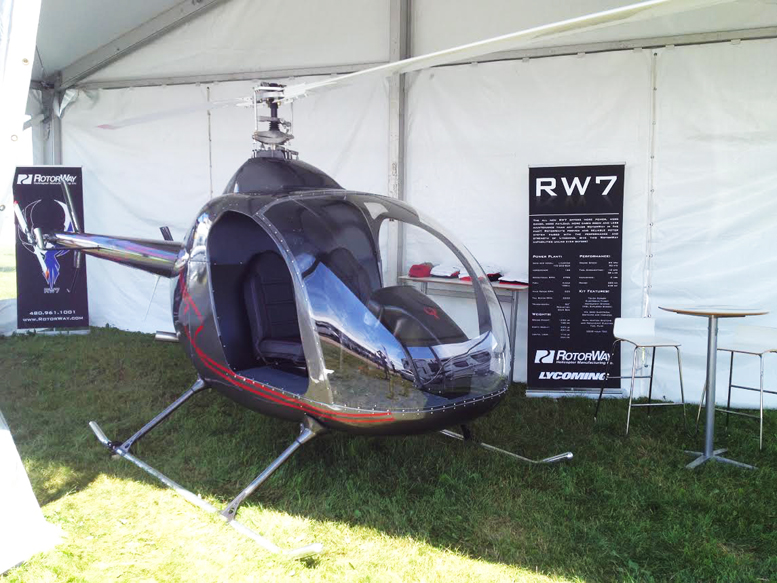
David Donaldson – Monday, July 20, 2015
Today RotorWay gave details of their latest project, the RW7. This aircraft uses the proven RotorWay rotor system and the super-reliable Lycoming IO-320 engine rated at 160hp. The helicopter has a new airframe and drivetrain including a 90 degree main gearbox and eliminating the belts and pulleys of previous models.
RotorWay gave details of their design objectives: “We wanted to produce a helicopter that has more capabilities and still looks and flies like a RotorWay….The new helicopter offers more payload, more cabin space and more range than previous RotorWay models. We also wanted the helicopter to be easier to build and easier to maintain.
The goal was to simplify the assembly by reducing the parts content and to streamline the drive systems….The Lycoming is air cooled so we eliminated the entire liquid cooling system there by saving weight, maintenance time and costs. Also the ignition system is magneto instead of the FADEC system used in previous models saving assembly time.”
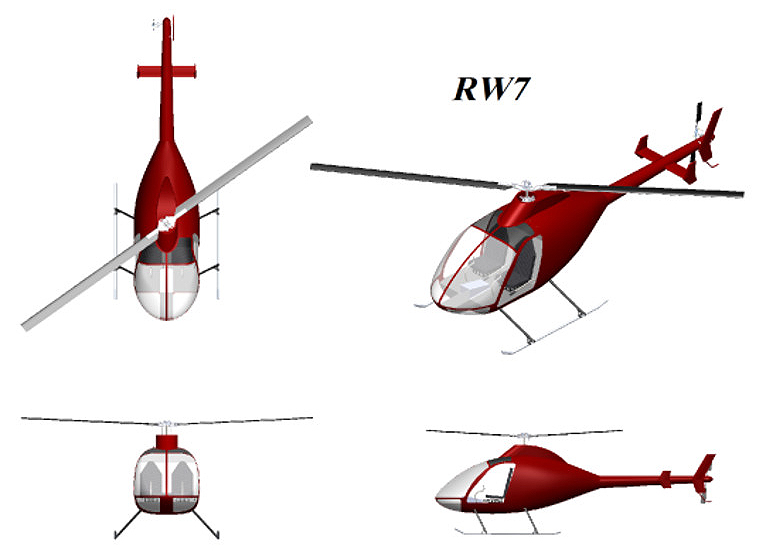
Other major changes are:
-
Aluminum Firewall and Floor.
-
New redesigned Tail Rotor Blades for increased efficiency.
-
Straight legged landing gear.
-
Gross weight of 1650lbs.
-
Mil – Spec wire harness and switches.
-
32 gallons fuel capacity.
-
MGL 8.5in Explorer-Lite EFIS.
-
2000 hour engine TBO
-
Oil cooler
The RW7 continues RotorWay’s commitment to providing safe, reliable and well designed and manufactured helicopters. Our commitment extends to our pricing of the RW7 as well, at US$117,900 for the complete kit, the price is well below that of any other helicopter kit powered by a Lycoming engine.
COURTESY: Rotorway Australia
The post Rotorway Exec Helicopter Kit appeared first on Redback Aviation.
